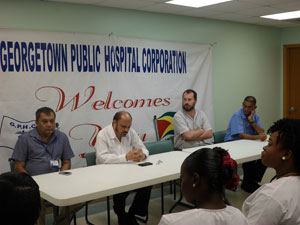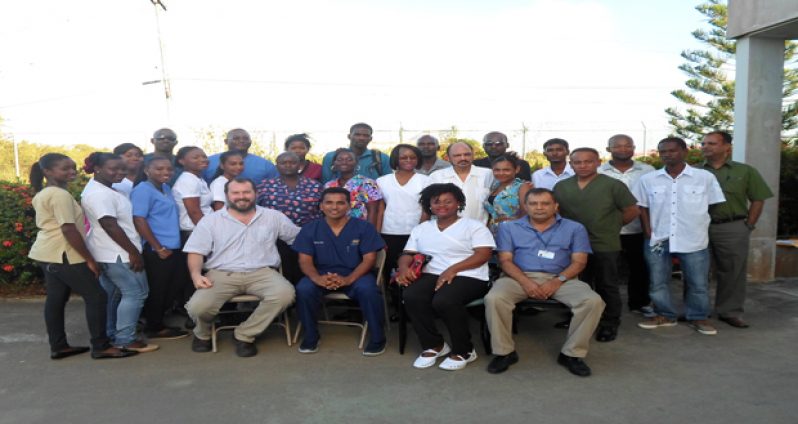THE Ministry of Health has made a giant leap forward in the area of Emergency Medical Response, with the graduation of its first ever batch of 22 Emergency Medical Technicians (EMTs) on Tuesday, following two and a half weeks of training at the Project Dawn Centre, Liliendaal, Greater Georgetown.

The programme was offered by the Ministry of Health, in collaboration with the Vanderbilt Medical Centre, in Nashville, Tennessee, USA, and among the resource persons were Chief Instructor, Shannon Langston from Vanderbilt and local Programme Director, Dr. Zulfikar Bux.
Among the key functionaries were Minister of Health, Dr. Bheri Ramsaran, Chief Executive Officer of the Georgetown Public Hospital, Mr. Michael Khan, Programme Director, Dr. Zulfikar Bux; Chief Instructor, Dr. Shannon Langston and Manager, Training and Development, Mr. Soogrim Singh, Dr. Sheik Amir and others.
In brief remarks to the gathering, Mr. Michael Khan noted that the occasion was historic, since it was the first batch of persons receiving EMT training locally, and they will soon be able to put their skills to use, in rendering pre-hospital care. They are the first line for health care in any emergency medical system.
Dr. Bux who is also a Consultant, Emergency Medicine and Head of the Emergency Department at the GPH, congratulated the participants of this first ever Emergency Medical Technician Course for the Public Health System in Guyana, adding that they are part of a privileged group.
Noting that the day marked an important event in the beginning of their lives as Emergency Medical Technicians, Dr. Bux urged them to work together as a team, adding that they have a chance to expand, with the aim of boosting the Emergency Medical team in Georgetown and Guyana as a whole.
Dr. Bux credited the course to the instrumentality of Dr. Madan Rambaran who has been pushing for it for a long time, and who agreed that it should be started with the Georgetown Public Hospital. Granted that it is successful, the initiative will be classified as a National Emergency System, he said.
He reiterated that their new found role is very important, since it is one that will save lives, adding, “Not a lot of people can actually have the opportunity to do that. Today you have a certificate, so that you have the opportunity to make impact in the lives of people in your country.”
Dr. Bux thanked Mr. Michael Khan for his support along the way; Mr. Amir, Medical Director who has always come forward when help was needed; Dr. Bheri Ramsaran for his input. Not least, he thanked the Partners from Vanderbilt Medical Centre for all they have done to create the National Emergency Medical Centre here, through the John Morris Foundation.
Dr. Bux acknowledged that most of the support and development work was done through the Vanderbilt Medical Centre, in collaboration with the Ministry of Health.
“Even though there is a far way yet to go, the important thing is that you have made the first step, and will work together as a team,” Dr. Bux encouraged the graduands.
Meanwhile, Dr. Shannon Langston, Chief Instructor, a representative of the Vanderbilt Medical Centre, joined in congratulating the graduands and wished them the best of luck.
Minister of Health, Dr. Bheri Ramsaran in his opening remarks cautioned the participants to approach the task at hand with caution, meaning that when they get into the ambulances provided for them to dispatch emergency medical cases in the Pre-hospital setting; they should do so with due care and diligence. Noting that they should ‘drive’ and not ‘fly’, the minister asserted, “I am happy that this is such a comprehensive course, that even the drivers will be taught to be responsible,” he said.
And earlier, at the handing over of ambulances to regional hospitals, the minister noted that it is on record that new ambulances are involved in their first accident within three weeks. He is hoping that this practice will be eliminated.
STRATEGIC PARTNERS
Acknowledging the contribution of the Vanderbilt Medical Centre and John Morris Foundation, Dr. Ramsaran referred to them as strategic partners. He said the Government of Guyana is looking for other strategic partners who can help them sustain the programme.
At the same time Dr. Ramsaran said that another team from Calgary in Alberta, Canada, will be coming to Guyana in a short while, and there will also be a return visit from George Washington University Hospital. “So our task now is to synergize these resources,” he said.
While thanking Vanderbilt for their pioneering role, Dr. Ramsaran said, “We in Guyana have to cherish this opportunity.” And to the graduating batch, while urging them to do so, Dr. Ramsaran affirmed, “You are going out there to save lives… Let it be your golden hour,” he told the graduands.
Meanwhile, now that they have secured the skills, the task of the Ministry of Health will be how to manage the Emergency Medical Technicians who will have to respond to the emergency needs of patients out there, getting them to hospital in a safe manner, the health minister said.
The Emergency Medical Technician Programme is a pilot project which will be based in Region 4, with the assistance of Dr. Bux who was himself trained at the Vanderbilt Medical Centre.
Among the 22 participants were five ranks from the Guyana Defence Force, and another five persons have been trained as dispatchers.
Who are Emergency Medical Technicians?
Speaking with reporters Dr. Bux explained that Emergency Medical Technicians are the personnel responsible in pre-hospital care. They are the first line for health care in any emergency medical system and are similar to paramedics, but at a lower level.
He said that there are different types of Emergency Medical Technicians: EMT Basic (the participants who graduated on Tuesday); EMT Intermediate and Full Emergency Medical Technicians. Once they have served efficiently and effectively for a certain period of time, within two years they can be paramedics.
In effect, the EMTs are responsible, within the pre-hospital system for taking care of patients who are injured in the public domain.
Applying CPR (Cardio-Pulmonary Resuscitation) technique, (where required) they can actually stabilise the patient and transport them effectively and in a timely manner to a hospital emergency room.
MEMS
The plan, Dr. Bux outlined, is to create a National Emergency Medical System (MEMS). In developed countries MEMS is part of Medical Tourism, but in effect it is more important. It is very important to hospital care. The Ministry of Health is doing a Pilot Project and a phased implementation – Phases One, Two, and Three as required.
Phase One starts with the Georgetown Public Hospital which is the National Referral Centre. Later it will be taken to the outlying regions and different parts of the country, but the aim is to start small, be able to micromanage it and later move forward.
Essentially, Dr. Bux is asking the public to understand that this is just a pilot project and the Ministry of Health would not be able to meet the needs of Georgetown, per se. The time will come when the project will be able to meet the needs of the entire country, but for now, it is just small.
“There will be times when persons will call for the 913 Ambulances and would still not be able to get them, because they are engaged with other patients,” he concluded.
Written By Shirley Thomas




.jpg)









